Fifth Generation Cellular for RVers and Boaters
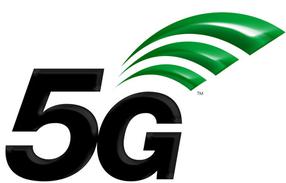 5G is shorthand for "fifth generation" cellular technology.
5G is shorthand for "fifth generation" cellular technology.
5G technology developed over several years and started to go mainstream in 2020 and is continuing a rapid pace of growth. In the coming years, it will become as pervasive as 4G, eventually replacing 4G as the dominant cellular technology.
As 5G expands, it is evolving toward 6G - the next major technology leap expected to arrive around 2030.
In this guide, we will explain 5G and how it impacts RVers and cruisers relying on cellular data for their mobile internet needs.
We actively update this guide and all of our content to keep up with this rapidly evolving technological shift.
This guide covers 5G technology at a high level. We also have related guides that go into more detail as well as our news stories and industry updates on our 5G page:
5G Cellular Resources For Mobile Internet
If you're a member, please log in above to see your exclusive content.
Don't need a membership? Other ways you can support our work here:
-
As seen in our videos!
-
Get a FREE Month of Starlink!
And our team will get one too!
-
Get a FREE Month of T-Mobile Unlimited Data
Join the Calyx Institute, and get a bonus month - and we do too!
-
Save $20 on Visible
Verizon's prepaid phone plan, we also get a $20 credit.
-
Leave a Tip!
Send our team some beer money!!
-
Share About Us!
Link to our content, tell others about MIRC. It's Free!
It is with huge gratitude to our members for making the free unbiased educational content on our site possible. We're not sponsored, you'll find no 3rd party ads and we don't sell gear or data plans.
Our members get exclusive access to our in-depth content, classrooms, vendor discounts (that can save you more than membership!), alerts, insider info and interactive guidance. They can even book private advising sessions.
If mobile internet is an important part of your lifestyle, consider helping make MIRC possible by joining or supporting our mission.
What is 5G?
Roughly every ten years, a fundamentally new generation of cellular technologies comes to market.
In 2010, the 4G/LTE era began when Verizon became the first United States carrier to embrace fourth-generation cellular technologies, moving from the limited mobile data capabilities of the 3G era towards the data-centric speeds and capabilities enabled by 4G.
Then, in 2020, this process was repeated with 5G technologies that built on LTE and substantially improved cellular connectivity. We are now well into the 5G era and it is a mature and mainstream technology. 6G is already on the horizon and is expected to come around 2030.
Why Evolve via Generations?

Cellular technology is based on common technical standards, which allow different device manufacturers, cellular carriers, and networking equipment suppliers worldwide to build to these standards and create interoperable gear.
If it weren't for standards, there would be chaos in the market.
But technology constantly evolves, and so do standards. The standards developed for the available technologies of the 1990s could never anticipate the technological advancements and market demands of the 2020s.
To strike a balance between interoperability and progress, the cellular industry works together to allow for a major change in the fundamental, underlying standards just once a decade, with continual smaller (but still backward-compatible) jumps made every few years between the major generational shifts.
The changes between different generations of cellular technologies come down to redefining the rules of how cell towers and devices communicate with each other, which allows new gear to be developed under those new specifications.
In other words, evolving the standards to take advantage of newer technologies enables a new generation of more advanced devices.
A Highway Analogy
Back in the 1960s the max highway length for a vehicle on most roads was 35' - effectively limiting how long buses and motorhomes could be made to legally operate on US roadways. These days, that max length is 45' - which means we have can have larger vehicles transporting more commercial goods across the country, buses that move more people, and motorhomes with more luxuries.
As technology advanced, the standards advanced - and the overall capability of the highway system evolved.
Cellular is evolving similarly, but at a MUCH more rapid pace!
For more on the past and to better understand the evolution of cellular technology, check out our guide looking deeper into the colorful history of cellular technologies:
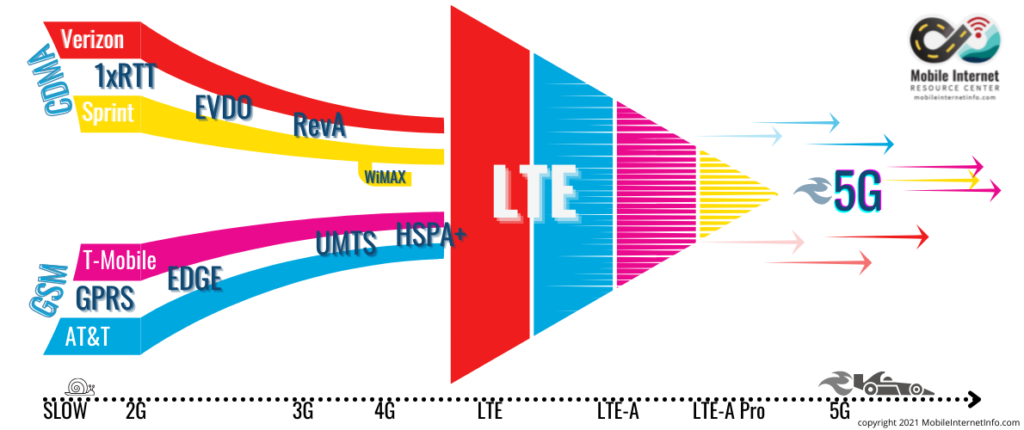
Benefits of 5G
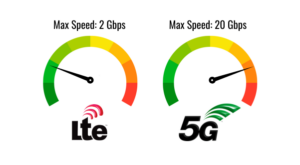
Fifth-generation cellular rethinks cellular networking to allow for much faster peak speeds, more data usage, substantially lower network latency, and cellular networks with vastly more connected devices than were possible in the 4G era.
Some examples of the capabilities that are changing thanks to 5G:
- Faster Speeds: The largest 4G channels are 20 MHz wide (think of them as a 20-lane highway), and carrier aggregation technology allows the most advanced 4G/LTE modems to combine up to eight different channels together for more capacity. This has enabled peak theoretical LTE speeds to reach well over a gigabit per second, but this is as far as 4G technology can be pushed. 5G technology, on the other hand, allows for 100 MHz and even 400 MHz wide channels (imagine 100 lanes of traffic on a highway!). Even more of these channels can be bonded together, and 5G radios can use these invisible airwaves more efficiently too. These technological advancements combine to open the door to peak theoretical 5G speeds of over 10 Gbps (gigabits per second) - with real-world speeds substantially over 1 Gbps already being seen in many areas. When 5G is fully developed, peak theoretical speeds should reach near 20 Gbps.
- More Data Usage: Few people can tell the difference between 50 Mbps and 500 Mbps (Megabits per second) for most applications. However, a faster network has the raw capability to serve more data to more people at once, meaning less overall congestion. This theoretically opens the door to carriers being less stingy with the limits on their data plans, and we have seen some of that with the carriers offering Home Internet options to compete with landline internet service providers.
- Lower Latency: 4G/LTE networks have a lot of built-in overhead that makes latencies (the round trip delay in the network) of less than 30ms nearly impossible to achieve. 5G networks are redesigned to allow latencies to eventually reach as low as 1 ms, enabling cellular to match even the fastest cable and fiber networks. Low latencies will enable everything from virtual reality and augmented reality headsets to self-driving cars that can communicate directly with each other in real time.
- More Network Capacity: Not every device needs crazy fast speeds or low latencies, and 5G networks are being designed to enable millions of low-cost and lower-performance devices—all connected at once in a way that would have overwhelmed 4G networks. Imagine cellular devices as basic as temperature sensors in a garden, with batteries that last for years without a recharge.
- Better Battery Life: 5G standards focus on improved efficiency, which translates into better battery life, all else equal. That power savings allows newer smartphones, for example, to support higher resolution screens and faster processors.
Though 5G changes the networking rules in some substantial ways, it is actually a direct evolution of 4G/LTE technologies, building upon an established foundation.
5G networks are already evolving well beyond LTE, offering performance and features that were not possible with LTE.
5G is fully mainstream, but LTE will continue for many years to come
5G is still evolving, but it takes time for networks and devices to catch up fully to where standards are. It is important to remember that while the 5G standards enable some incredible advancements, it will take time for all these benefits to actually make it out into the world.
Cellular evolution is a relay race. 4G/LTE is running out of steam, and it is passing the baton to 5G - but LTE will remain a player for years to come.
The first generation of 5G devices is already obsolete, and the current generation will look like dinosaurs compared to the 5G devices we see a decade from now.
And as when this decade ends, 6G will be ready to leap into the race.
Join our Next MIRC LIVE: 2025 Cellular Mobile Internet Update - 5G Networks & Modems
Plan to join us live on Wednesday, March 19th at 7PM eastern when MIRC founder Chris Dunphy will be joined by Andrew McNabb to talk about the state of 5G and the evolution of cellular networks and modems in the United States. There will be a Q&A at the end to interact with the team.
Click this link, and you can subscribe to our YouTube channel and click the 'bell' to be notified with a reminder. This is a free public event, part of our MIRC LIVE series.
After the broadcast, this same video link will serve as an archive to view whenever you like.
2023 5G Industry Update
Chris provides a 2023 state-of-industry update on 5G and an overview of 5G modems.
5G Frequencies
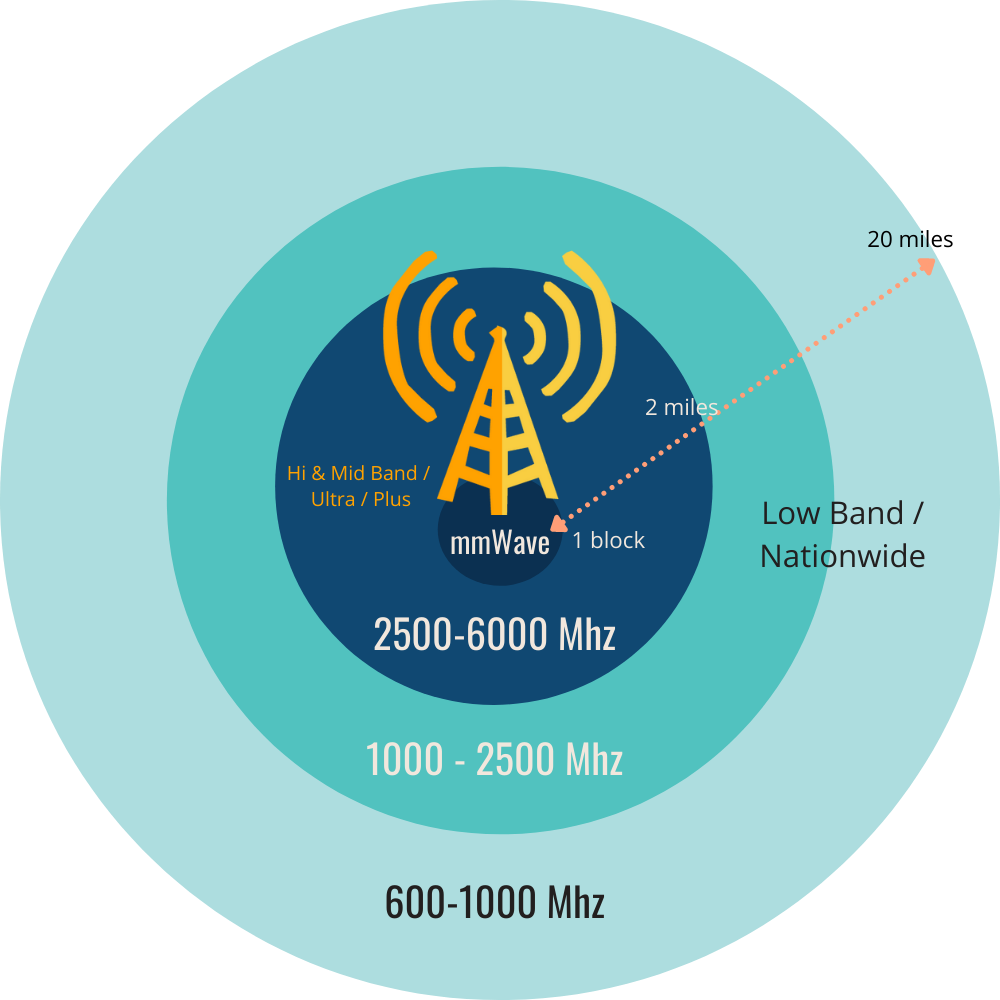
Delivering on the promise of 5G requires new radio technologies and new chunks of wireless spectrum to broadcast upon.
5G is opening new frequency bands and reutilizing existing lower and mid-range bands used by 4G/LTE and retired 3G networks.
These different frequency bands have different general performance traits, and they are grouped into three types: mmWave (millimeter wave), mid-band, and low-band.
You can think of these as layers in a cake. Each is part of the cake but has unique flavors and characteristics.
Each carrier approaches its 5G deployments differently, depending on its spectrum holdings and other factors. Most carriers are focusing on mid-band frequencies, which provide a good balance of speed and range.
To find out where the carriers are currently at, and what bands they support, see our Major Carriers Guide.
Here is more about the layers of the 5G frequency cake:
mmWave
These super high-frequency signals are great for speed, but they do NOT travel far through the air, and walls and windows can easily block them. This means that mmWave 5G networks only provide 5G service within a block or so (or even less) of the typically streetlight-mounted mmWave 5G transmitters. This mmWave technology is excellent for delivering 5G service in places where many congregate - like stadiums, city centers, airports, and shopping malls - eliminating dreaded network congestion.
Many of the earliest 5G deployments focused on these extremely high-frequency millimeter wave (mmWave) signals. mmWave will rarely be the type of 5G that RVers and cruisers will encounter since it is deployed in dense urban areas.
With mmWave coverage, speeds can be expected to be measured in the Gbps.
Mid-Band
This spectrum provides a good balance of speed and range, and it's considered the sweet spot. It's the key to a truly "next-generation" 5G experience.
Many of the mid-band frequencies use new spectrum that carriers are still deploying, so this is the fastest-changing area of 5G.
With mid-band, anticipate speeds measured in the hundreds of Mbps, and coverage reaching a few miles from the towers.
Low-Band
This spectrum is mostly already used by the carriers for their 4G/LTE networks today, and it is being repurposed to provide 5G over long ranges. Additionally, some frequencies previously used for 3G are being repurposed for 5G.
Low-band 5G can reach most anywhere 4G/LTE is available today, providing nationwide 5G even in rural locations. But this low-band, long-range 5G technology can not defy the laws of physics - and if you are only in a low-band coverage area, 5G will not be able to deliver performance much beyond "really good 4G" in many places. The carriers are also not yet refarming spectrum from LTE to 5G, so in some cases, the LTE low-band performance can be a lot faster than 5G low-band.
For more on understanding the trade-offs of different cellular frequencies, check out our guide:
Understanding Cellular Frequencies
5G Indicators
 Each carrier takes a different path to fully deploying its 5G networks. While each carrier has a single, big network that devices connect to, the carriers have subdivided some of the layers in the cake into service tiers in their marketing and data plans.
Each carrier takes a different path to fully deploying its 5G networks. While each carrier has a single, big network that devices connect to, the carriers have subdivided some of the layers in the cake into service tiers in their marketing and data plans.
When connected, your device will show what type of 5G you are currently connecting to. Unfortunately, these are not standardized across all carriers.
Here's how the carriers are labeling their 5G flavors, which are explained in greater detail in the "5G Race" member section below:
Verizon
- 5GUW - mmWave and mid-band spectrum
- 5G - Low-band / "Nationwide" 5G
AT&T
- 5G+ - mmWave and mid-band spectrum
- 5G - Low-band / "Nationwide"
- 5Ge - LTE-Advanced (NOT 5G, despite the label!)
T-Mobile
- 5GUC - mmWave and mid-band spectrum
- 5G - Low-band 5G.
Dish
- 5G - Only one indicator is shown
Member Exclusive Content Below
Member Exclusive Content In This Guide
Has this guide been helpful so far?
Well.. there's a lot more below available to our members. As well as dozens of other guides like this, videos, classrooms, forums, webinars and more. All specifically created for helping keep RVers, cruisers and nomads online.
Consider Becoming a Member
If mobile internet is an important part of your lifestyle, a membership can help keep you connected with these exclusive benefits:
- in-depth exclusive content
- interactive guidance
- vendor discounts
- alerts & insider tips
- classroom
- community
Free Content Like This Made Possible By Our Members!
We are community funded via our premium membership program - allowing us to focus on creating unbiased quality, in-depth, constantly updated content. We don't accept 3rd party advertising, we're not sponsored and we don't sell 'stuff'.
Already a member?
Log in to continue with this guide.
Check out the Topics Covered in the Member Section:
Dynamic Spectrum Sharing
We discuss how 5G cooperates with the existing 4G network and spectrum, allowing a much smoother transition from 4G/LTE to 5G, and explain how and when this will affect mobile users.
Standalone vs Non-Standalone 5G
The first wave of 5G networks is mostly layered on top of existing 4G networks - but eventually, all 5G networks will run standalone without needing 4G assistance, providing significant benefits. We explain the details in this section and why it's a factor consideration for mobile users.
Fixed vs Mobile 5G
Not all 5G is intended for mobile usage, and many 5G devices (and data plans) are targeting fixed-location installations to compete with cable and fiber internet. We discuss the important differences in these approaches and how they might be useful for nomads.
5G Cellular Gear
5G requires carriers and consumers to upgrade their gear for compatibility. This section discusses 5G compatibility with modems, antennas, and boosters and focuses on the key technologies and gear to look for.
5G Data Plans
Here, we summarize how 5G affects legacy and grandfathered data plans, examine the current 5G data options, and anticipate the future. We also go into greater detail on how each carrier categorizes 5G access for data plans.
The 5G Race
All carriers are actively and competitively deploying 5G. In this section, we chronicle where Verizon, AT&T, T-Mobile, and Dish/Boost are in the race and explain which carriers are best positioned for 5G now and in the future.
Is it Time to Embrace 5G?
5G has been out for a few years now. In this section, we give our analysis and advice on whether or not to jump into 5G and what factors nomads should be aware of.
Concluding Thoughts
5G has developed to the point where it is no longer the domain of early adopters and bleeding-edge geeks, and it is now a mainstream technology and should be considered the default option when buying new gear.
But 5G still has many more years of development left, and the cellular carriers still have far more work to expand their 5G coverage, and especially capacity.
It is very important to be aware of the capabilities of the 5G device you buy to ensure it has a cellular modem that will be relevant in the future.
If you were waiting to jump onto 5G, there is no reason not to consider it now.
Additional Reading
Related Guides
Explore the Resource Center
Have Questions?
Join our 'Library Desk':
Internet for RVers & Cruisers Facebook Group
We cross post news articles and guides, and can help point you in the right direction to our content here on the resource center.
It is with gratitude to our premium members that we're able to offer our free content - and for that, they also have access to our member Q&A areas for more in-depth guidance.
Become a Member
 The MIA is our premium membership - designed for those who consider mobile internet an important part of their lifestyle.
The MIA is our premium membership - designed for those who consider mobile internet an important part of their lifestyle.
In thanks for making content like this possible, we offer a bunch of additional perks. From interactive guidance, in-depth member exclusive content, discounts, alerts, classroom and ability to book private advising sessions.
Stay In the Know
We're constantly tracking the industry and analyzing new developments for mobile travelers. If you'd like to receive updates, we offer several ways:
- Subscribe to our free monthly newsletter
- Subscribe to our News Stories RSS Feed
- Subscribe to our YouTube Channel
- Follow our Facebook Page
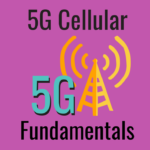







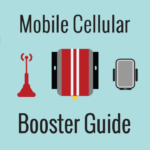


 Mobile Internet Resource Center (dba Two Steps Beyond LLC) is founded by Chris & Cherie of
Mobile Internet Resource Center (dba Two Steps Beyond LLC) is founded by Chris & Cherie of